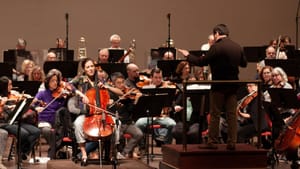Stay in the Loop
BSR publishes on a weekly schedule, with an email newsletter every Wednesday and Thursday morning. There’s no paywall, and subscribing is always free.
Reviled then, beloved now
The Delaware Symphony Orchestra presents ‘False Starts’

Just as resolutions begin to vanish, Maestro David Amado kicked off the new year with False Starts, a Delaware Symphony concert of works that had challenging premieres. Though each piece was excellently realized by both orchestra and stellar soloist, the concert made more programmatic sense on the page than for the ear.
The evening was centered around a moving realization of Elgar’s deeply soulful, sorrowful cello concerto, featuring swift-rising French soloist Camille Thomas. Amado bookended this elegiac composition with two brash Russian works—Borodin’s Prince Igor Overture and Rachmaninoff’s Symphony No. 1, a Delaware premiere. Both the Elgar and Rachmaninoff had rough symphonic starts, hence the concert title.
Prince Igor’s start
The opener was the overture to the well-known opera Prince Igor by Alexander Borodin (1833-1887), a respected chemist whose parallel career as a composer began in the 1860s. Borodin wrote music sporadically and left this opera unfinished. Its overture was completed by his student Alexander Glazunov, who worked from sketches and memories of the composer at the piano.
It begins with a cushion of strings, quickly augmented by woodwinds and a brass fanfare. The work is packed with energy, thematic switches, sectional and instrumental highlights, and a Turkish-style march, all delivered with gusto by the well-balanced orchestra. As it accelerated, this curtain-raiser made you feel as though an opera might suddenly appear.
The breakdown before the triumph
The evening’s second half was the Symphony No. 1 of Sergei Rachmaninoff (1873-1943). Now considered a classic in the Russian tradition, it had such an unfortunate 1897 premiere that it drove the composer to a breakdown that haunted him for the rest of his life. Contemporary accounts cite the ill-prepared orchestra and incapacitated (probably drunk) conductor Glazunov. When Rachmaninoff went into exile in 1917, he left this score in Russia, and the work virtually disappeared until 1945, when it was reconstructed from salvaged orchestra parts.
Rachmaninoff inventively navigates symphonic format: Bending, expanding, and meandering through traditional structure, he unified the four-movement piece with a persistent motif based on the Latin Dies irae plainchant. Its dramatic ebbs and flows deliver the expected Russian fireworks, unexpected pauses, syncopation, and exciting “false” endings. It’s also packed with orchestral riches and gorgeous instrumental obbligatos.
Speaking before the concert, Amado said he hoped the evening “would make a case for this unique and seldom-performed work,” and he led the DSO in a performance whose verve and excellence was certainly convincing.
The emotional center
Closing the evening’s first half—programmed directly after the rousing Borodin overture—was the evening’s emotional centerpiece: the deeply ruminative Cello Concerto in E Minor of Edward Elgar (1857-1934). Fortunately, a substantial pause to reset for the soloist allowed audience and orchestra preparation time for this introspective, moving work.
Written while Elgar’s wife was dying, it, too, had a rocky premiere. The composer led the London Symphony in the work's 1919 debut, but the rest of the concert was conducted by Albert Coates, who gave Elgar little rehearsal time. Though heard again a year later, it was seldom played afterwards and was resurrected in the 1960s by the great cellist Jacqueline du Pré.
Soloist Camille Thomas said it was du Pré’s highly praised recording that cemented her passion for the instrument and for this unusual work. Elgar’s writing for soloist is virtuosic but not obvious or flashy, and features an unusual ongoing dialogue with the orchestra.
The four-movement piece opens dramatically but quickly moves to a haunting lament introduced by the violas, picked up by the basses, and then handed to the cellist. Throughout, the work meshes soloist and orchestra, including magical passages where the cello and an entire section (most excitingly, the basses) play in perfectly achieved unison, with Thomas’s beautiful, often unanticipated, cadenzas arising organically.
Strength, delicacy, and finesse
The work’s transparency and delicacy—with its shifting rhythms, lush modulations, and intricate dialogues subtly led by Thomas—demand a pristine ensemble and orchestral finesse, both here achieved by the DSO.
A rising star, Thomas—who clearly adores this work—played with technique that undergirded but never overpowered the emotional riches of her illuminated and technically thrilling interpretation. For a mid-concert encore, she played Song of the Birds by Pablo Casals, a solo with Spanish overtones that (like her entire performance) melded strength and delicacy.
This beautiful rendition of the Elgar by soloist and orchestra could have been the concert finale, but at least its placement afforded the audience excited intermission conversations. Just prior to the concert, principal timpanist Bill Wozniak pointed out the DSO’s newly acquired (and beautiful) timpani, with calfskin heads whose mellow sound balanced sweetly in the orchestra. And—another instrumental note—Thomas plays the gorgeous 1730 “Feuermann” Stradivarius, a cello so resonant that you can practically hear the march of history in its sonorous sound.
What, When, Where
False Starts. Borodin, Overture to Prince Igor; Elgar, Cello Concerto in E minor; Rachmaninoff, Symphony No. 1 in D minor. Conducted by David Amado. Camille Thomas, cello. The Delaware Symphony Orchestra. January 17, 2020, at the Grand Opera House, 818 N. Market St., Wilmingonton, DE. (302) 656-7442 or delawaresymphony.org.
The Grand is ADA-compliant and fully accessible. It has wheelchair and companion seating.
Sign up for our newsletter
All of the week's new articles, all in one place. Sign up for the free weekly BSR newsletters, and don't miss a conversation.

 Gail Obenreder
Gail Obenreder